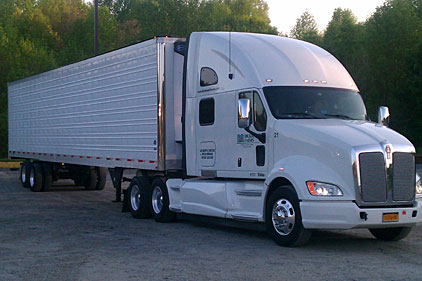Cold Supply Chain & Logistics: Rail progress

It’s no secret that refrigerated and frozen transportation is a dynamic, commoditized market. In fact, the only predictable market factors are the peaks and valleys in rates and capacity.
Throughout these boom, bust, revenue and demand cycles, refrigerated shipping has absorbed driver shortages, fuel increases, regulation and legislation. Still, it remains one of the world’s most competitive markets. Refrigerated truck and rail have been shippers’ two main long-haul options (in excess of 1,500 miles). Interestingly, there now are more variations than ever before within these two basic modes.
There are multiple sizes of private and railroad-owned boxcars in manifest (mixed railcar) trains, dedicated unit trains (one type of railcar from one origin to one destination) and trailer-on-a-flat-car (TOFC) intermodal. For the first time in years, shippers also have a choice involving domestic intermodal refrigerated containers (COFC).
Each option presents unique operational, financial and service characteristics. Here’s a review.
Boxcar Manifest Service (two-truckload to four-truckload capacity railcars)
Large, bulk volume refrigerated and frozen food shippers use this form of manifest train, which can include multiple car types (either owned by private companies or the railroads). This network relies on boxcar rail-served facilities at each end.
On-time is typically with a week of published transit time. Savings (depending on incremental storage and handling cost calculations) are between $.01 to $.02 per pound or $400 to $800 per truck. With one transload added, a shipper or consignee can quickly erode any savings versus truck.
Again, shippers best suited for this service are those with relatively dense, stackable, large volume loads containing a low total number of SKUs. Small shippers have very limited access to large railcars. Product tends to be floor loaded or slip sheeted on and off the railcars. Crushing can be a challenge with the larger interior heights exceeding 11 feet. The Union Pacific Railroad has the largest number of refrigerated railcars and the largest market share. It offers shippers a West Coast “Express Lane” program with 10-day service to the Northeast.
Boxcar Unit train
This offering features large-capacity railcars (three to four truckloads) with transit times approximating single-driver service. The Union Pacific offers two of these trains through Railex. These coast-to-coast trains run two days per week of scheduled service from the Pacific Northwest and Southern California to Upstate New York in a five-day period.
Each train has the capacity to transport the equivalent of 1,120 trucks of perishable product in each direction. These trains provide speed, consistent capacity and forward position of inventory or door-to-door delivery at a savings to truck. Although capacity and service are excellent throughout the year, one drawback is that this model includes multiple handles on the freight.
Refrigerated intermodal
Shippers now have two options: a trailer on a flat car (TOFC) or the recent addition of double-stack refrigerated containers on a well car (COFC). Intermodal is an excellent substitute for single-driver truck service between the West, East and Midwest. Payload and transit time is approximately equal to truck and priced at a savings of $.005 per pound, or $200 or greater per truckload. The BNSF railroad was an early market innovator here and continues to be the market’s largest rail provider of refrigerated intermodal services.
Almost all large refrigerated trucking companies offer intermodal services to complement their highway divisions. The largest refrigerated intermodal carrier in TOFC is Alliance Shippers with more than 1,600 intermodal trailers.
As mentioned, the newest market development involves domestic refrigerated intermodal double-stack containers. This service offers the additional efficiency of double-stack rail transit density and is projected to provide savings over TOFC but not boxcar.
We are beginning to see new service offerings using these containers. One such example is the dedicated refrigerated double-stack container train that BNSF offers through Rail Logistics LLC. This network operates from the state of Washington to Chicago (and back) and it is adding critical capacity between major markets.
Several large refrigerated intermodal carriers are exploring this new mode or already have committed to adding containers to their fleet. The nation’s largest refrigerated carrier (C.R. England), has committed to 300 containers to be delivered within the year.
Observers project that the domestic refrigerated container market will grow from near zero in 2010 to more than 1,000 units by the end of 2011. Some challenges here may include chassis management, weight and cube payload maximization versus lower weight trailers.
Market maneuvers
In the recent past – when there were only two or three truck/rail options – the value or savings gap between boxcar rail and highway truck was significant, ($.02 to $.03 per pound or $800 to $1,200 per truckload). Today, however, that gap has narrowed. Regulations and fuel prices have increased truck costs. Even so, costs likewise are rising in the more efficient rail mode.
The biggest change in rail’s value proposition is that it’s more difficult to identify cost or value differences between truck and rail. In some cases, rail options either match or exceed available truck rates. And although truck costs remain largely transparent, it is more difficult to pinpoint “cost drivers” behind rising rail prices.
That said, rail offers critical consistent service and supply in a tight capacity market. And of course, when capacity is a problem, rates ultimately rank a distant second to perishable transportation supply.
We’re entering a critical time period. Driver and operating regulations, operating costs and capital constraints are reducing truck capacity. Meanwhile, environmental measures and engine requirements are pushing most late-model trucks and refrigerated trailers into the secondary market.
There are still more variables as larger carriers choosing not to manage a California-only fleet. In turn, they are upgrading all other assets. Elsewhere, smaller carriers may not be able to invest or command the rates needed to support new investments.
Refrigerated rail equipment and technology investments and innovation are adding critical capacity to shippers and receivers. We expect to see rail options fill the capacity void. However, as rates inch upward, it will only blur the cost and value differences between these modal options.
Executive insights: Birds Eye view of logistics
Refrigerated & Frozen Foods talks with Mike Nardella, vice president of logistics for Pinnacle Foods Group LLC. Pinnacle is the Mountain Lakes, N.J., parent to such frozen food brands as Birds Eye®, Aunt Jemima®, Mrs. Paul’s®, Van de Kamp’s®, Swanson Hungry-Man®, Celeste® and Lender’s®.
R&FF: Pinnacle is a large, diversified company. How is your job structured?
Mike Nardella: Shortly after the (December 2009) acquisition of Birds Eye Foods, Pinnacle Foods Group reorganized into three business units: the Duncan Hines Grocery Division, the Birds Eye Frozen Division, and the Specialty Foods Division.
Logistics is part of a shared services group. Our team interacts with each separate business unit in both a tactical as well as strategic function. Since my team is broken down into a dry (which also services the Specialty unit) and frozen group, we are able to address the specific needs of each group.
R&FF: What were your biggest challenges and successes in calendar 2010?
Nardella: Our biggest challenge was to integrate the Birds Eye business within our logistics network in just under six months. We structured logistics for efficiency and moved some logistics functions in house. Although this was a difficult task, it also proved to be our biggest success. We executed the transition with a great deal of precision and accuracy. In addition, we were able to achieve all of our planned synergies.
R&FF: What were your Birds Eye objectives during the second half of last year?
Nardella: Once the integration was complete, we wanted to better understand this new business. This, in itself, was a challenge. We were in our [vegetable] growing season and the harvest was starting to come in. We needed to anticipate and plan for overflow bulk storage warehouses. Today, we still feel as though there are many aspects of the business we need to work through. That will include our logistics footprint.
R&FF: What industry issues give you the most cause for concern? Why?
Nardella: There are a few areas that get my attention. These are issues such as truck and driver capacity, effects of the CSA 2010 regulation, EOBR (electronic logs), new safety regulations and rising fuel costs. All these issues and developments appear to present a “perfect storm” for carriers.
R&FF: What are a few frozen warehousing goals for calendar 2011?
Nardella: We believe flexibility and speed at the docks will be very important. One goal will be to ensure that we gain additional flexibility to accommodate drivers upon arrival.
R&FF: How about a few frozen transportation goals?
Nardella: There will be several frozen warehouse initiatives. In conjunction, however, we do need to work with our base of frozen carriers. We want to maximize efficiencies by reducing empty miles and better accommodating drivers at loading docks.
R&FF: What will be the frozen food industry’s most critical logistics challenge in calendar 2011?
Nardella: I think we’re just seeing the tip of the iceberg with respect to transportation regulations. Although we can anticipate some of the effects of regulations: new safety requirements, rising fuel costs, driver shortages, etc; we cannot project the real impact. We know one thing. Whatever happens will shape the logistics frontier and the competitive supply chain environment.
Those companies competing for capacity must develop creative solutions and strategic partnerships. I also see more manufacturers collaborating in areas of planning and operations to create win-win situations for both carriers and manufacturing.
R&FF: Now a lighter question. What Pinnacle product is in your home freezer?
Nardella: Of all our frozen products, I particularly enjoy Birds Eye Voila! Garlic Chicken. It is as good as an entrée from a restaurant and offers a hearty portion. I’d encourage everyone to try it.
MEET MIKE NARDELLA
Background: Nardella has more than 35 years of transportation and logistics at corporate and third-party companies. He co-founded an on-line returns business and has held various senior level supply chain posts at M&M/Mars, Johnson and Johnson, Playtex, Genco Logistics and Avon Products.
Education: B.S. Business Logistics; MBA, Penn State University
FYI: Nardella holds two patents related to bulk material handling systems and returns processing. He has held logistics association program and conference chair positions and served on executive boards overseeing the Warehousing Education Research Council and Council of Supply Chain Management Professionals.
Looking for a reprint of this article?
From high-res PDFs to custom plaques, order your copy today!



